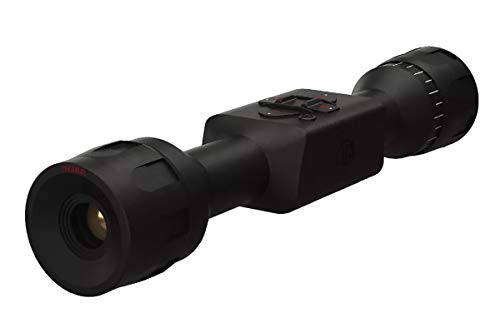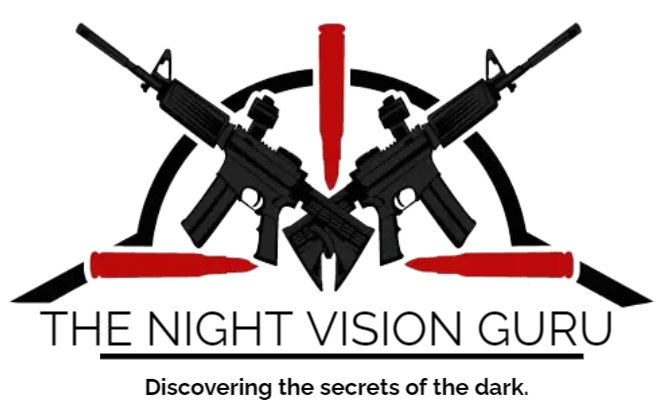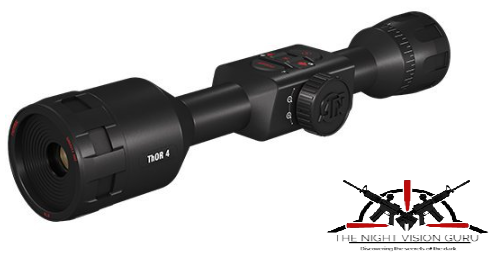TheNightVisionGuru.com is a participant in the Amazon Services LLC Associates Program, an affiliate advertising program designed to provide a means for sites to earn advertising fees by advertising and linking to Amazon.com. Read more.
As coyote hunting gains popularity, we thought we’d look at the most effective gear for the job: the best thermal scope for coyote hunting.
Thermal scopes greatly simplify hunting any form of elusive prey, especially predators like coyotes, who are notoriously cunning in the wild. Moreover, they are primarily nocturnal.
So let’s look at the complete thermal scopes available for taking down these cunning animals to make your next coyote hunt a bit easier, and then we’ll discuss how to pick the one that best suits your needs.
The Top 8 Thermal Scopes for Hunting Coyotes
Here are some of our top-recommended options:
1) ATN Thor 4 640 1-10x – Best Overall
The ATN Thor 4 640 1-10x comes first. In all honesty, this perspective is more intelligent than I am. It has so many built-in functions that it would be impossible to list them all in this space.
The top-notch 4th generation 640480 60hz thermal sensor from ATN is where it all begins. The inbuilt computer upscales the image from the HD sensor’s startling clarity to a 1280×720 display.
The 60hz refresh rate makes it possible to track movement in real time without experiencing any noticeable lag. Additionally, it has 16 hours of battery life, a bright mil-dot reticle that mimics a long-range FFP reticle, and enough inbuilt sensors to make you feel like you’re in a sci-fi movie.
It has a recoil-activated mode so that every time you pull the trigger, the ensuing footage gets permanently stored on an SSD card, making it an excellent alternative for evaluating and sharing footage from your hunt. It captures video in 1280960 resolution.
Additionally, you may use WiFi to connect this device to your desktop, tablet, or phone and view the film there. Additionally, it has Bluetooth capabilities, allowing you to control the film, modify settings, and perform other back-end modifications using an Apple or Android mobile.
And finally, it includes a gyroscope, ballistic calculator, accelerometer, magnetometer, GPS for geotagging and elevation tracking, and more. And even though it has all of that, it’s simple enough to operate, especially if you download the app; you can be up and running in about 20 minutes.
Overall, this scope is incredibly well-designed, has excellent build quality, and has many valuable functions. It is our top choice since it is ideal for coyote hunting, including the magnification range.
Pros
- Price
- Gen 4 640 sensor
- White/Black/Color palettes
- Smart Mil-Dot Reticle
- Smart Rangefinder
Cons
- Needed learning curve
2) AGM Rattler TS25-384 – Best Short Range
 The AGM Rattler TS25-384 represents the top of the mid-range market. The TS35 model has a 35mm lens for more extended detection and greater optical magnification but at the penalty of a constrained field of view and a higher price. The TS25 model has the same features. The TS25 fits the bill for under $2000.
The AGM Rattler TS25-384 represents the top of the mid-range market. The TS35 model has a 35mm lens for more extended detection and greater optical magnification but at the penalty of a constrained field of view and a higher price. The TS25 model has the same features. The TS25 fits the bill for under $2000.
China is where the Rattler line is produced. AGM does not service the scope even though it has a limited 3-year warranty; nonetheless, it will be replaced as part of the guarantee (requires registration).
The Rattler is a riflescope with five interchangeable reticles in the colors of black, white, green, or red, yet its small size of 7.37″ and weight of 0.91 lb makes it appear to be a monocular. Additionally, it supports five zero settings and has a. 308-caliber recoil rating.
A 0.4″ 1024×768 OLED display is coupled with a 17-micron, 50Hz, uncooled core. It boasts a broad 14.9×11.2° FOV, a 45mm eye relief that is respectable for a thermal, 1.5x optical magnification, and digital zoom levels of 1x, 2x, 4x, and 8x. The detection range for large objects is 965 yards, but the identification range is 150–200 yards.
It runs for 4.5 hours on two CR123A or RCR123A (rechargeable) batteries and is compatible with an additional 5V battery pack. Fusion, White Hot, Red Hot, and Black Hot are standard palette modes.
It includes two scene modes: jungle and recognition. While Jungle mode emphasizes heat signatures on minor things, Recognition mode amplifies the target’s outside edges.
The PIP mode, which is especially helpful for varmint and predator hunters, is a highly praised feature. Crosshairs are visible on the primary and PIP screens while in PIP mode.
Additional features include more user-adjustable settings, built-in video and image capture storage, and WiFi capability. The AGM Rattler TS25 is a mid-range, high-performance scope that offers value for the money.
Pros
- 384×288 resolution
- 1.5x optical magnification
- Large display
- Multiple features
- Compact/lightweight
Cons
- Limited warranty.
3) AGM Varmint LRF TS35-384 – Best Range Finder
 In most cases, night-stalking hunters can only use stadia metric or bracketing rangefinder alternatives. This problem is resolved by the AGM Varmint LRF, which incorporates a laser rangefinder into the thermal scope itself.
In most cases, night-stalking hunters can only use stadia metric or bracketing rangefinder alternatives. This problem is resolved by the AGM Varmint LRF, which incorporates a laser rangefinder into the thermal scope itself.
The Varmint LRF runs for 4.5 hours on a rechargeable 18650 battery while the WiFi is turned off. You will need to use an external battery pack to get the most out of all the functions while using it in the field. A thermal needs more power as it develops more capabilities.
The specifications are of mid-range quality with a 0.4″ 50Hz, 1024×768 OLED display and a 384×288, uncooled VOx, 12-micron core. The Varmint LRF series’ least expensive model, the TS35-384, has a maximum detection range of 1913 yards. It has a 3-24x magnification range, a 45mm eye rest, and a 7.53×5.65° FOV.
The max range and accuracy of the built-in laser rangefinder are 656 yards and 2 yards, respectively. You can see what you need to range with the help of the thermal, and you can instantly determine how far away your target is, day or night.
The Varmint also has a trajectory correction option that allows you to specify various drop expectation distances. Picture-in-picture mode with 5 onboard reticles shown on both the main screen and PIP screen will be highly regarded by hunters.
The AGM thermal riflescope includes four color schemes, scene modes for the jungle and recognition, and hot tracking. You may now live stream using the app on your phone in addition to the 16GB of internal storage for video and image recording.
It is small for a fully functional thermal, measuring 7.8″. It is 4.9 feet drop-resistant and has an IP67 water resistance rating. The Varmint LRF combines LRF technology in a mid-range thermal sensor scope and will rapidly become a Varmint hunting essential for evening outings.
Pros
- Mid-range
- 656-yard LRF range
- 3-24x magnification
- Live video streaming
- Compact
Cons
- Its battery life is small.
4) Burris BTC 35 – Best Clip-On
 Typically, clip-on thermal scopes cost more than thermal riflescopes. The Burris BTC 35 is a strong contender in a market with very few options. Its 400×300, 17-micron, 50 Hz sensor gives it mid-range performance. 35mm lens, 1x magnification (2x/4x digital), and 10.6×8° FOV are among the specifications.
Typically, clip-on thermal scopes cost more than thermal riflescopes. The Burris BTC 35 is a strong contender in a market with very few options. Its 400×300, 17-micron, 50 Hz sensor gives it mid-range performance. 35mm lens, 1x magnification (2x/4x digital), and 10.6×8° FOV are among the specifications.
The BTC’s late delivery of the clip-on adapters required to convert it from a monocular to a weapon-mounted clip-on with daylight optics was the main criticism leveled against it. It’s also quite upsetting that the adapters are sold separately while costing much more than the handheld.
It is crucial to be aware of this in advance because it is still one of the few clip-ons on the market.
It can be fitted to the objective bell of a daylight riflescope or affixed to a Picatinny rail made for red dot use. It has a Bluetooth controller and a photo rail that are offered separately. For 3+ hours of operation, it needs two CR123 or ICR16340 rechargeable batteries. A battery charger is provided in the box by Burris.
Although the BTC is criticized for having basic features and functionality, its offerings are comparable to thermal scope rivals. Although it does not have internal video, it does have a video output for an external recorder.
It contains three scene modes: Enhance, Highlight, and Nature, White, Black, Red, and Green Hot Palettes, and Hot Tracking. Other features include manual focus, automatic standby/power-off, shutter/scene/calibration adjustments, and adjustable brightness/contrast.
Despite being a Burris optic, it is only protected by a Thermal 3-Year Warranty, which begins on the day of purchase and needs registration and a receipt. Although this might also be criticized, all other manufacturers’ thermal warranties are competitive.
The BTC is a pricy clip-on when you include the added cost of adapters and accessories. The BTC provides nothing less than different clip-ons in addition to video capture.
Pros
- Clip-on
- Mid-range
- Hot Track
- Basic functions
- Compact/lightweight
Cons
- supplied separately are adapters
5) ATN Thor LT 160 3-6x – The Best Budget Option
 The ATN Thor LT is currently the least expensive thermal riflescope on the market. The LT 160 is a budget-friendly model with a 17-micron, 60 Hz sensor, and a max resolution of 160×120. The fact that thermal imaging costs less than $1,000 merits praise for its accessibility to budget-conscious buyers.
The ATN Thor LT is currently the least expensive thermal riflescope on the market. The LT 160 is a budget-friendly model with a 17-micron, 60 Hz sensor, and a max resolution of 160×120. The fact that thermal imaging costs less than $1,000 merits praise for its accessibility to budget-conscious buyers.
Budget ATN scopes have a history of having problems where the screen freezes, and a hard reset is necessary. Many people find it the solution, but it will fail you if you require a second attempt. Early after the Thor LT release, these criticisms were common, but they have been less prevalent lately.
The Thor LT 160 is a low-resolution thermal, which is the first thing you should be aware of! Even so, short-range thermal imaging is a cheap option that may be appropriate for novices. The Thor LT has a human detection range of 465 yards and a 160-yard ID range. Although many variables are involved, performance is probably between 70 and 200 yards.
Although the LT can operate in temperatures between -20 and 120 degrees Fahrenheit, it dislikes the cold. Thermal technology prevents it from liking high humidity. It is a good illustration of how you will discover its potential and limitations because you will lose resolution in high-humidity environments, which forces a closer ID range.
Many people would appreciate it if ATN removed all the technological amenities, such as WiFi and video. Its White and Black Hot palettes, reticle settings, and amazing 10+ hour battery life from its internal, rechargeable battery all maintain its simplicity.
Its shape resembles a daylight scope, and mounting requires 30mm ring mounts, which are not provided. Although the Thor LT 160 is as entry-level as they come, it satisfies any financial demands novices may have for their first thermal.
Pros
- Price
- Short-range
- Long eye relief
- Ultra-long battery life
- Ring mounting
Cons
- Screen freezing
Choosing The Best Thermal Scope for Coyote Hunting: What to Look for
Budget
Even while thermal technology is generally out of reach for most people’s budgets, it is not inaccessible. These days, high-quality thermal scopes are available for less than $2000 at several price points.
The most expensive sensors will be those with 640×480 resolution, 12-micron, and 60 Hz refresh rates. Prices for these sensors may start at $3000-$4000 on the low end, but don’t be shocked if you see them approaching $10,000.
If you reduce the resolution by half, the thermal becomes more affordable, but the resolution is also reduced by half. Reduce it once more to 160 resolution, for example, and the thermal quality and cost trend is still present.
Focus vs Clip-on
A standalone thermal is utilized exclusively on a weapon system, which is how the differences differ. A clip-on is intended to be used in front of your daylight scope to give thermal imaging, while it may or may not support independent use.
The drawback of purchasing a standalone thermal rifle sight is that it requires a different weapon or that the daylight scope be removed.
A clip-on is ideal for switching weapon systems and utilizing the daylight scope. Still, frequently the image quality may be compromised because it must pass through numerous glass lenses before your eye can see it.
However, the most recent products demonstrate value without visual deterioration.
A clip-on may be a better choice if you only sometimes hunt coyotes to minimize day scope dismounting and remounting. A dedicated thermal scope can be a justifiable investment if winter has arrived and you expect to be outside frequently.
Environments for Coyote Hunting
The vast plains, the hill country, and, more recently, the wooded habitats are where you are. It would help if you had the appropriate thermal for the task.
Even though coyote hunting usually involves moving around, you must avoid skylines, keep the wind in your face, and have the proper equipment to avoid being observed.
This means you should purchase a portable thermal scope with imaging qualities that can be modified for the environment and a recognition range at least as wide as your shooting range.
Coyote hunters in open areas and flat fields will need a long-range thermal scope. Because covering land is the ideal tactic in this environment, those who live in thick timber, where coyotes have been moving in recent years, will require a lightweight thermal system.
Thermal goggles could also be a good option because calls aren’t getting as far on hard scouting days. Make sure the thermal is recoil-rated for the shotgun you’re using.
Lightweight and Powerful
Make sure your system is portable and light. For coyote hunting, most varmint and scout weapons are popular options; the same should be true of your thermal choice.
Your gear should be valuable and appropriate for the hunt rather than weighing you down, as you should be on foot and moving around frequently.
Thermal scopes have consistently weighed in like a tank. Even though it was enormous due to the electrical components, glass, and lenses, it wasn’t any more resilient or recoil-proof than modern devices constructed of lightweight, robust aluminum alloy materials.
Manufacturers are simplifying thermal scopes to resemble daytime scopes in terms of aesthetics and weight, which is now less than 2 lbs. With dedicated scopes weighing about 24 oz, thermal clip-ons can be as light as 18 oz.
FAQs on The Best Thermal Scope For Coyote Hunting
1) Can a Thermal Scope be Used in Daylight?
Yes! Unlike night vision scopes, thermal scopes are active instruments that can be used continuously during the day and at night (comparison here). Thermal scopes take temperature readings and turn the information into images that the viewer can understand. It can therefore be utilized in the daylight.
The only thing to be mindful of is how heat and daylight impact targets, animals, and the surrounding environment’s temperature signatures. The image may “wash out” when several of these targets produce identical heat signatures.
Before firing, you must recognize and identify your target. It would help if you also used the characteristics of the thermal scope to improve the image and help you identify your target.
2) Is coyote hunting better with thermal imaging or night vision?
Both thermal and night vision allow for significantly improved identification and detection. I’m one of many folks who use an ATN OTS Thermal monocular for detection and an ATN X-Sight 4K for identification and shooting.
3) When are coyotes most active during the day?
Coyotes do not only exist at night. Although they can be seen throughout the day, they tend to be most active at night and after sunset. Coyotes may be more visible and audible between January and March when they are mating and when their young are leaving their family groups (October – January).
4) What kind of magnification is necessary for coyote hunting?
Magnification in the 14x–20x range is more appropriate for longer shots if you want to ensure that you can see anything small, like a coyote, and deliver a precise kill shot. I enjoy an adjustable 4–14x lens.
Conclusion
Even if thermals provide many valuable and functional advantages for a hunt, we must confess that they are entertaining. A primordial feeling has visibility in the darkness to kill the unwary predator.
It is, however, also a costly experience. Justify it by taking up hog hunting, finding downed game, and nighttime ranch surveillance. Once darkness falls, more than chickens might try to hide in the coop.
We hope this post helped you find the best thermal scope for coyote hunting. You can also check 6 Best Budget Night Vision Scopes {Buying Guide}


